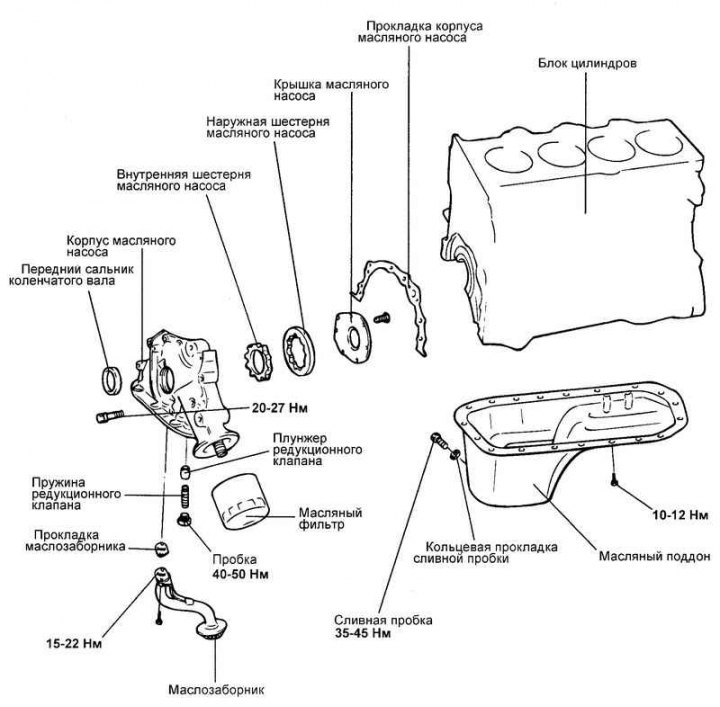
Pic. 2.186. Lubrication system components
Combined lubrication system: spray and pressure. Under pressure, the main and connecting rod bearings and camshaft bearings are lubricated. The system consists of an oil sump, gear oil pump with oil receiver, full flow oil filter, oil pressure switch and oil valves.
The oil pump draws oil from the engine sump and delivers it to the oil filter. There is a bypass valve on the pressure side of the oil pump. If the oil pressure is too high, the valve opens and some of the oil flows back into the engine sump.
Through the middle of the oil filter element, clean oil enters the main oil line. When the filter becomes clogged, a bypass valve located in the oil filter housing supplies unfiltered oil directly to the main oil line. There is a non-return valve in the oil filter pipe, which prevents the oil passages and hydraulic valve lifters of the engine from emptying. Channels for lubricating the crankshaft bearings depart from the main oil line. Through inclined holes in the crankshaft, oil is supplied to the connecting rod bearings, and from there it is sprayed onto the piston pins and cylinders. At the same time, oil is supplied through ascending channels to the cylinder head and ensures lubrication of the camshaft bearings and the operation of hydraulic tappets.
Oil consumption
Speaking of oil consumption in an internal combustion engine, we mean only the amount of oil that is consumed due to the combustion process (waste consumption). Under no circumstances should oil consumption be confused with oil loss due to leaks in the oil pan, cylinder head cover, etc. Normal oil consumption occurs due to the combustion of a small amount in the cylinders, as well as due to the removal of combustion residues and wear particles. Oil wears out under the influence of high temperatures and high pressure that occurs in the engine cylinders. Oil consumption is also greatly influenced by external factors, such as driving style, as well as the accuracy of the manufacture of engine parts.
The maximum allowable oil consumption in operation can be 1.0 liters per 1000 kilometers.
When the minimum mark is reached, the oil must be topped up (the amount of oil to be added must not exceed 1 liter).
Attention! On vehicles equipped with engines with a catalytic converter, it is necessary to ensure that the oil level on the dipstick is not above the maximum mark. If too much oil has been poured into a car with a catalytic converter, the excess must be removed from the crankcase by draining or suction (special vacuum pump), otherwise unburnt oil will enter the exhaust system and may destroy the catalytic converter.
The choice of oil for the engine lubrication system
All-weather oil is used to lubricate Hyundai car engines. Multigrade oils have the advantage that they can be used in both winter and summer. All-weather oils are based on liquid seasonal oils (e.g. viscosity grade 15W). By means of so-called thickeners, the oil is stabilized in the hot state, so that the necessary lubricating properties are ensured for each state. «W» according to SAE classification indicates that this oil can be used in winter.
Low-speed oils are all-weather oils with antifriction additives; their use can save fuel up to 2%. Lightweight oils have a low viscosity (e.g. 10W-30). They require a special foundation (synthetic oils).
Recommended API Oil Grade: HE BELOW SG or SH.
Recommended oil viscosity grade according to SAE: depending on the expected ambient temperature until the next oil change.
